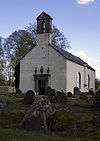Durrow Abbey
|
| |
| Monastery information | |
|---|---|
| Established | 553 |
| People | |
| Founder(s) | Saint Columba |
| Architecture | |
| Heritage designation | National Monument |
| Site | |
| Location | near |
| Public access | yes |
Durrow Abbey is a historic site in Durrow, County Offaly in Ireland. It is located off the N52 some 5 miles from Tullamore. Largely undisturbed, the site is an early medieval monastic complex of ecclesiastical and secular monuments, visible and sub-surface.
The extant monuments at the site include a large ecclesiastical enclosure, five Early Christian grave slabs, a fine mid-ninth century high cross, a fragment of a cross shaft, a complete cross-head (housed in the National Museum of Ireland) and cross base, a holy well and other extensive archaeological features. Hugh de Lacy, Lord of Meath built a motte for the Abbey in 1180, and he was killed at the Abbey in 1186 by an Irishman.
Early history

The original monastery at Durrow was founded by St Columba in 553, who also founded 26 other monasteries by the age of 25, including the Abbey of Kells. He ran the Abbey until 563, when he moved to Scotland, appointing a monk, Cormac Ua Liathain, to take his place. Cormac found it impossible to retain the office of prior because of the rivalries between the northern and the southern clans, especially on the borderland, and so left the monastery, leaving in charge Columba's first cousin, Laisrén, who was acceptable to both sides. Durrow, during Columba's life and for centuries after his death, was a well known center of education. The Venerable Bede called it Monasterium nobile in Hiberniâ, and, at a later period, Armagh and Durrow were called the "Universities of the West". Durrow, like Clonard, Derry, and most other monasteries in the area, was frequently ravaged by the Vikings, but was not completely destroyed until the Norman invasion.
The famous illuminated manuscript Book of Durrow, now at Trinity College, Dublin, was at the abbey by 916 at the latest, although it was probably made elsewhere. Discovered in the hands of a local farmer after the Reformation, the book is regarded as the earliest surviving fully decorated Insular Gospel book. It is believed to date from the 7th or 8th century, though the date is a matter of long-standing controversy.
The site itself, originally called Daru (plain of the oaks) is the location of some of the only remaining pre-mediaeval oak in Ireland. The line of oak trees which lines the fields to the side of Durrow Abbey also marks the route of the ancient highway of Ireland.
From an architectural perspective, the site contains two interesting features: Durrow Abbey House — a building of significant quality dating to the 1920s when it was rebuilt after a fire that left the roof and interior destroyed[2] — the church dating from the late eighteenth/early nineteenth century which itself is built on the footprint of at least one previous church, dating from medieval times. It is also suggested that the medieval church was itself built on the site of a former 12th century abbey church.
The house and land has recently been leased to the Founder of the Arts for Peace Foundation, which will use the house and grounds as the venue for a recreational respite centre for children from conflict zones.
In 1998, Mrs O'Brien the Owner, began negotiations with Julie Lowe, of the Durrow Abbey Trust, to sell the estate for £2million. Lowe is a descendant of The O'Donnells of Donegal, who are part of the family of St Columba. St Columba founded Durrow in 553AD. Although the deal with Lowe fell through, the estate was saved for the people of Ireland in 2003.
The Government has bought Durrow Abbey and its accompanying 6th century monastic site in Co Offaly at a cost of €3.175 million. The purchase of the sixth century site, founded by St Columcille, and part of the historic Durrow Abbey estate, is designed to protect the Abbey and heritage elements from proposed commercial development on the lands. The vendor was Ms Sheila O'Brien. The Minister of State at the Office of Public Works, Mr Tom Parlon, described the acquisition as "a true asset in the State's property portfolio".
Other De Lacy associated monuments and structures
Gallery
-

High Cross
-

Columcille's Church Exterior
-

High Cross and church interior
-

Grave Slabs
-

The Abbey
-

The Abbey Side View
-

The Abbey
See also
References
External links
- Irish midlands ancestry
- http://www.offalyhistory.com/content/reading_resources/books_articles/durrow_monastery.htm
- http://www.artsforpeace.ie/contacts.html
 This article incorporates text from a publication now in the public domain: Herbermann, Charles, ed. (1913). "School of Durrow". Catholic Encyclopedia. New York: Robert Appleton.
This article incorporates text from a publication now in the public domain: Herbermann, Charles, ed. (1913). "School of Durrow". Catholic Encyclopedia. New York: Robert Appleton.
Coordinates: 53°19′33″N 7°31′11″W / 53.325952°N 7.519670°W
